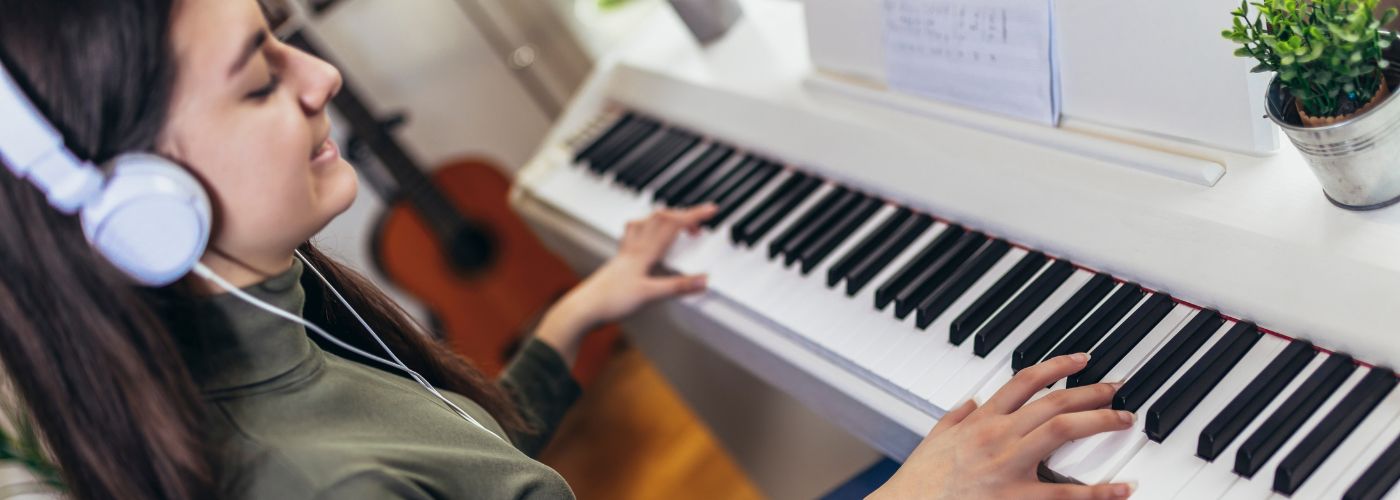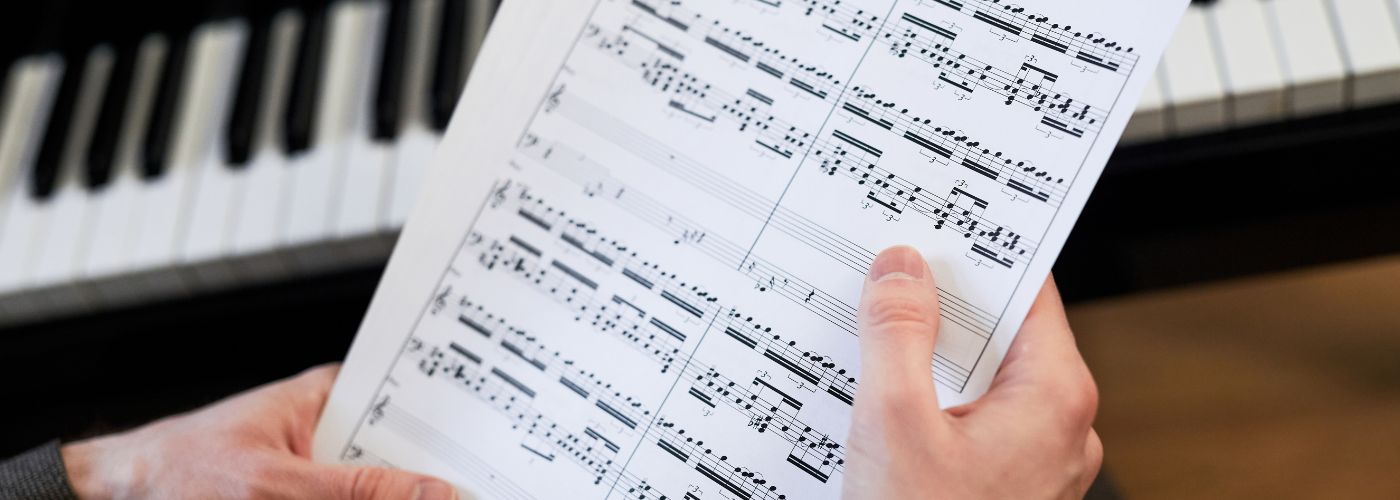Playing the piano as a beginner can be exciting and challenging, but developing a consistent practice routine will help build your skills quickly and enjoyably. Below, we outline some of the best piano exercises to help beginners improve finger strength, develop rhythm, master sight reading, and introduce basic music theory.
Best Piano Exercises For Beginners
Starting with simple exercises helps beginners get comfortable with the piano’s keys and layout. Scales, arpeggios, and simple finger exercises are excellent for building familiarity and confidence. These are some great exercises that are taught during piano lessons. For example, practicing scales strengthens your fingers and builds a sense of the musical key, which is essential when playing any song. Beginners can start with:
- Major Scales: Begin with C Major, which has no sharps or flats, and work up and down an octave. Gradually, other keys like G Major and D Major will be introduced.
- Arpeggios: Playing chords as broken or arpeggios across the keyboard helps develop dexterity and finger coordination.
- Five-Finger Exercises: Practice playing five notes (e.g., C-G) with each hand to improve the strength and independence of each finger.
Working on these exercises for 10-15 minutes each practice session can significantly improve hand position and technique.
Introducing Basic Chord Progressions
Chord progressions are the foundation of many songs, making them an ideal next step after mastering basic scales. Familiarizing yourself with simple chord progressions, like the I-IV-V-I (C-F-G-C in C major), helps develop a sense of harmony and prepares you to accompany melodies.
- Start with Triads: Practice three-note chords, or triads, for each scale degree. This will help you understand how chords work within different keys.
- Play Common Progressions: Once you’re comfortable with major and minor chords, try some easy progressions like C-Am-F-G or C-G-Am-F, both used in popular songs.
- Practice Hands Together: When you feel confident, try playing progressions with both hands, using the left hand for the bass note and the right hand for the full chord. This helps with coordination and lays the groundwork for more complex accompaniment.
Understanding basic chord progressions will give you a more comprehensive understanding of music, making it easier to play with others or improvise.
Use Hanon Exercises for Finger Independence
The Hanon exercises are a series of repetitive but highly effective piano exercises designed specifically to strengthen each finger and improve speed, precision, and finger independence.
- Begin with the First 20 Exercises: Start with the easier Hanon exercises, which focus on basic finger movements and scales. These exercises are perfect for beginners.
- Play Slowly and Increase Speed: Initially, practice each exercise slowly, ensuring that each finger strikes the keys with equal strength. Gradually increase speed over time to improve accuracy and agility.
- Consistency Is Key: The Hanon exercises are meant to be practiced daily. Aim for 5-10 minutes per session to see a gradual improvement in your finger independence.
With regular practice under the guidance of a piano teacher, these exercises help prevent finger strain and allow for smoother, more controlled playing, especially when playing complex pieces.
Ways to Practice Sight Reading as a Beginner
Sight reading is a crucial skill for playing new music with minimal preparation. This skill improves over time but benefits from consistent practice.
- Start with Simple Pieces: Begin with beginner-level sheet music, focusing on rhythm and note recognition rather than speed.
- Use a Metronome: Sight reading requires a steady rhythm. Practicing with a metronome helps you maintain a consistent tempo and focus on keeping time instead of correcting mistakes.
- Focus on Patterns: To improve your reading speed, recognize common patterns, such as intervals (the distance between notes) and simple chord structures.
- Practice Daily: Sight reading for a few minutes daily helps build familiarity with musical notation and rhythm. Try using different daily pieces to expose yourself to various styles and keys.
Learn Easy Songs for Beginners
Nothing motivates me more than being able to play actual songs. Start with simple, familiar songs that reinforce your learning skills, such as hand coordination and reading notes.
- Choose Familiar Melodies: Begin with songs that have simple rhythms and structures, such as “Twinkle, Twinkle, Little Star” or “Ode to Joy.” These songs are often available in simplified versions for beginners.
- Practice Hands Separately First: Start by learning the melody (right hand) and bass notes (left hand) separately, then try playing them together once you feel comfortable.
- Gradually add Complexity: As you master simpler songs, try pieces with more complex rhythms or melodies. Look for beginner arrangements of popular tunes or classical pieces like Bach’s “Minuet in G.”
Learning easy songs provides a sense of accomplishment and encourages you to practice more regularly.
Use Online Resources and Apps for Effective Practice
With today’s technology, many online tools and apps can supplement your learning, making practice sessions more interactive and enjoyable.
- Apps like Simply Piano and Yousician offer guided lessons, practice tools, and feedback to help beginners learn independently.
- YouTube Tutorials: Many experienced teachers post free tutorials for popular songs and piano exercises on YouTube, allowing you to learn songs outside your practice books.
- Sheet Music Websites: MuseScore and IMSLP offer free sheet music downloads for beginner pieces, which can be great for expanding your repertoire.
- Rhythm and Ear Training Apps: Apps like Tenuto and Rhythm Cat provide exercises for ear training, interval recognition, and rhythm practice, helping to develop musicality beyond just playing.
These resources can provide structure, variety, and inspiration for new players, especially when lessons are not readily available. Not using one of these sources is one of the biggest mistakes when learning piano as a beginner.
Tips for Staying Consistent as a Beginner
The key to progressing in piano is consistent, structured practice. Here are some additional tips to help beginners stick with their learning:
- Set Small, Achievable Goals: Focus on mastering a new scale or completing a Hanon exercise each week.
- Establish a Routine: Even 20 minutes of daily practice is more beneficial than a long session once a week.
- Record Your Progress: Listening to recordings of yourself over time can highlight improvements and boost motivation.
- Celebrate Small Wins: Every piece learned, or exercise mastered is a step forward. Celebrate these milestones to stay motivated.
By focusing on these fundamental exercises and using available resources, beginners can build a solid foundation in piano and steadily work toward more complex music. Patience and practice are essential, but with these tools, learning piano can be a fun and fulfilling experience.



Continue Reading
Creative Ways to Encourage Practice at Home for Young Musicians
Have you ever watched a child lose interest in their instrument after just a few
Jul
Top Breath Control Exercises For Singers
Have you ever noticed how some singers seem to effortlessly hold long notes while others
Jun
How Does The Suzuki Piano Method Work?
Have you ever wondered why some children seem to pick up music so effortlessly? The
May